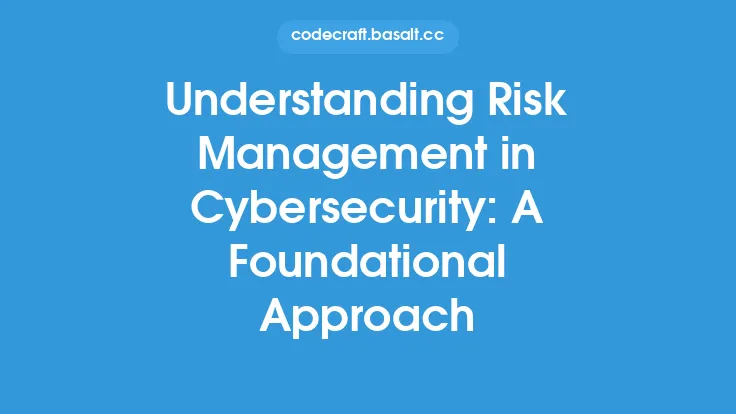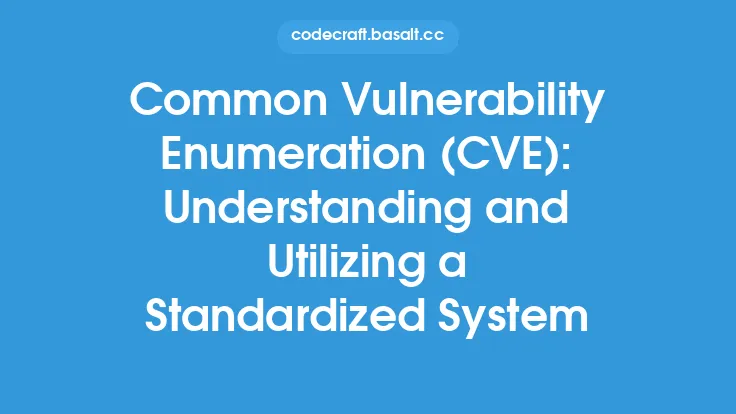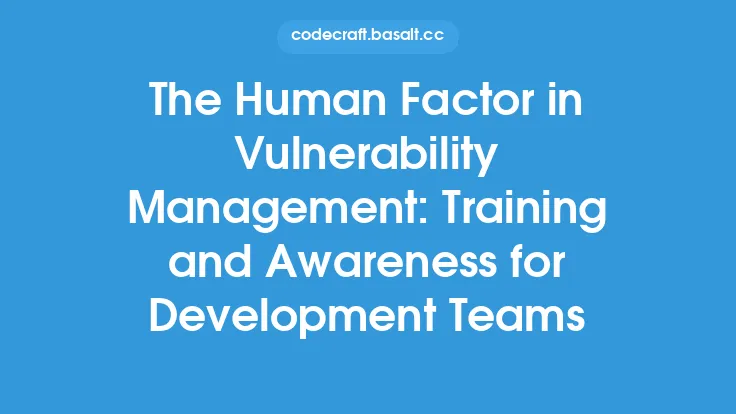Vulnerability management is a critical component of any organization's cybersecurity strategy. It involves the identification, classification, prioritization, and remediation of vulnerabilities in systems, networks, and applications. The goal of vulnerability management is to reduce the risk of exploitation by attackers, thereby protecting sensitive data and preventing financial loss. In this article, we will delve into the foundational aspects of vulnerability management, exploring its key concepts, principles, and best practices.
Introduction to Vulnerability Management
Vulnerability management is a proactive approach to cybersecurity that focuses on identifying and addressing potential weaknesses in an organization's systems and networks. It is a continuous process that involves regular scanning, assessment, and remediation of vulnerabilities. The process typically begins with vulnerability scanning, which involves using specialized tools to identify potential vulnerabilities in systems, networks, and applications. The identified vulnerabilities are then classified and prioritized based on their severity and potential impact on the organization.
Key Concepts in Vulnerability Management
There are several key concepts in vulnerability management that are essential to understanding its principles and best practices. These include:
- Vulnerability: A vulnerability is a weakness or flaw in a system, network, or application that can be exploited by an attacker to gain unauthorized access or disrupt service.
- Threat: A threat is a potential occurrence that could compromise the security of an organization's systems or data.
- Risk: Risk is the likelihood and potential impact of a threat exploiting a vulnerability.
- Asset: An asset is a system, network, or application that is critical to an organization's operations and requires protection.
- Exploit: An exploit is a piece of code or a technique used by an attacker to take advantage of a vulnerability.
Principles of Vulnerability Management
Effective vulnerability management is based on several key principles, including:
- Continuous monitoring: Continuous monitoring involves regularly scanning systems, networks, and applications to identify potential vulnerabilities.
- Risk-based prioritization: Risk-based prioritization involves prioritizing vulnerabilities based on their severity and potential impact on the organization.
- Remediation: Remediation involves taking corrective action to address identified vulnerabilities, such as applying patches or implementing workarounds.
- Verification: Verification involves verifying that remediation efforts have been successful and that vulnerabilities have been addressed.
Vulnerability Management Lifecycle
The vulnerability management lifecycle is a continuous process that involves several stages, including:
- Discovery: The discovery stage involves identifying potential vulnerabilities in systems, networks, and applications.
- Classification: The classification stage involves categorizing identified vulnerabilities based on their severity and potential impact.
- Prioritization: The prioritization stage involves prioritizing vulnerabilities based on their severity and potential impact.
- Remediation: The remediation stage involves taking corrective action to address identified vulnerabilities.
- Verification: The verification stage involves verifying that remediation efforts have been successful and that vulnerabilities have been addressed.
Tools and Techniques in Vulnerability Management
There are several tools and techniques used in vulnerability management, including:
- Vulnerability scanners: Vulnerability scanners are specialized tools used to identify potential vulnerabilities in systems, networks, and applications.
- Penetration testing: Penetration testing involves simulating an attack on a system or network to identify potential vulnerabilities.
- Configuration management: Configuration management involves managing and tracking changes to system and network configurations to prevent vulnerabilities.
- Patch management: Patch management involves applying patches and updates to systems and applications to address identified vulnerabilities.
Best Practices in Vulnerability Management
There are several best practices in vulnerability management that can help organizations improve their vulnerability management programs, including:
- Implementing a vulnerability management policy: A vulnerability management policy outlines the organization's approach to vulnerability management and provides guidance on vulnerability identification, classification, prioritization, and remediation.
- Conducting regular vulnerability scans: Regular vulnerability scans help identify potential vulnerabilities in systems, networks, and applications.
- Prioritizing vulnerabilities based on risk: Prioritizing vulnerabilities based on risk helps ensure that the most critical vulnerabilities are addressed first.
- Implementing a remediation plan: A remediation plan outlines the steps necessary to address identified vulnerabilities and prevent future occurrences.
Challenges in Vulnerability Management
There are several challenges in vulnerability management that organizations may face, including:
- Limited resources: Limited resources, such as budget and personnel, can make it difficult for organizations to implement and maintain effective vulnerability management programs.
- Complexity: The complexity of modern systems and networks can make it difficult to identify and address vulnerabilities.
- Evolving threats: Evolving threats, such as zero-day exploits and advanced persistent threats, can make it challenging for organizations to stay ahead of potential vulnerabilities.
- Compliance: Compliance with regulatory requirements and industry standards can be a challenge for organizations, particularly those in highly regulated industries.
Conclusion
Vulnerability management is a critical component of any organization's cybersecurity strategy. It involves the identification, classification, prioritization, and remediation of vulnerabilities in systems, networks, and applications. By understanding the key concepts, principles, and best practices in vulnerability management, organizations can improve their vulnerability management programs and reduce the risk of exploitation by attackers. Effective vulnerability management requires a proactive approach, continuous monitoring, and a commitment to remediation and verification. By prioritizing vulnerability management, organizations can protect their sensitive data, prevent financial loss, and maintain the trust of their customers and stakeholders.





